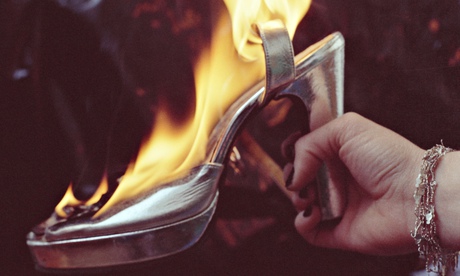The titles of Alexis Hunter's works of art say it all: Approach to Fear; Voyeurism; Violence: Destruction of Evidence; Identity Crisis; Effeminacy; Sexual Warfare; Masculinisation of Society; Oh No!; Dialogue with a Rapist. These were the ideas and themes that preoccupied Alexis, who has died of motor neurone disease aged 65, and that she explored from the 1970s onwards in a series of conceptual works using photography, film and text.
Finding that "it was too hard to be a feminist artist on your own; the criticism was too great to bear", in 1972 she joined the Artists Union Women's Workshop in London, alongside the feminist photographers and film-makers Tina Keane, Mary Kelly, Margaret Harrison and Annabel Nicolson.
Alexis had come across the use of contact sheets in the work of the US conceptualist Douglas Huebler. She continued to work in series of photographs. Her work was the most provoking at the almost all-female 1978 Hayward Annual. The combined influence of advertising storyboards, documentary, politics and feminism can be seen in the Object Series, 1974-75, portraying men as sex objects, in leather trousers and naked from the waist up. In one image, the twin towers of New York's World Trade Center are strategically sited as a phallic image. In the Sexual Rapport Series, 1972-76, she stamped her street photographs of men: "Yes", "No" or "Maybe".
Her long series Approaches to Fear featured her own bejewelled hands, with painted nails, caressing oil-soaked motorbike engines and high-heeled silver platform ankle-strap shoes. The critic Lucy Lippard noted: "Fetishism and a hint of S&M lurk just beneath the surfaces of Hunter's photographs … Her rage at capitalism is focused upon the mass media which have, as Judith Williamson puts it, been 'selling us ourselves' for profit."
Alexis was born in Auckland, New Zealand. Her parents Joan (nee Atthill) and Jack had moved there from Australia with their confectionery firm Sweetacres. They loved the New Zealand bush, Joan was an amateur archaeologist and they settled in Titirangi, near Auckland. Alexis wrote: "I grew up in an area favoured by … immigrants from Holland, Germany and Sweden. They brought ideas of politics, sexual diversity, interest in other cultures and importance of artistic work to the small village area of Titirangi."
She attended Elam School of Fine Arts, Auckland (1966-69), where she was influenced by the socialist ideas of her tutor, the painter Colin McCahon. She travelled to London in 1972 to join her twin sister Alyson, a photographer, and her partner Darcy Lange, the artist and documentary photographer and film-maker. To earn a living, Alexis worked in advertising, commercial film and animation, including on Raymond Briggs's The Snowman (1982).
I did not see her work for some years after the Hayward show, until the exhibition Impossible Document: Photography and Conceptual Art in Britain 1966-1976 at the Camerawork gallery, London, in 1997. She told John Roberts, its curator: "It was the way conceptual art emphasised and utilised the perception of the viewer that was so useful to feminist artists. It was a way of connecting directly to other women."
After that, every time I saw her, we laughed and said: "Must do a show." In 2006, I curated, and edited the catalogue for, Alexis Hunter Radical Feminism in the 1970s for the Norwich University of the Arts Gallery, which we then took to the Bunkier Sztuki gallery in Krakow.
Alexis always said she was not anti-men but anti-patriarchy. This she defined as the formation of power within groups of men to exclude women, both economically and politically. Sexual Warfare (1975) features her hands holding the book How to Make It in a Man's World. Alexis always retained her sense of humour. In an interview published in Le Monde in 2013, she said: "I think feminism is too radical, even for liberalism."
In 2013, Alexis's Approach to Fear XIII: Pain – Destruction of Cause 1977, showing the hands burning those silver shoes, was purchased by Tate. She was included in WACK! Art and the Feminist Revolution at the Museum of Contemporary Art, Los Angeles, in 2007. Recently her work has been shown by the Richard Saltoun gallery in London and the Whitespace gallery, Auckland.
In 1986 she married Baxter Mitchell. Together they owned the Falcon pub in Camden Town, north London, one of the great indie music venues of the late 1980s and 90s, where Pulp, Blur and Oasis played. She dealt with her diagnosis of motor neurone disease in as "unfazed" a manner as she could, latterly communicating via an electronic notepad.
She is survived by Baxter, her mother, and two sisters, Linley and Alyson.
• Alexis Jan Atthill Hunter, artist, born 4 November 1948; died 24 February 2014










